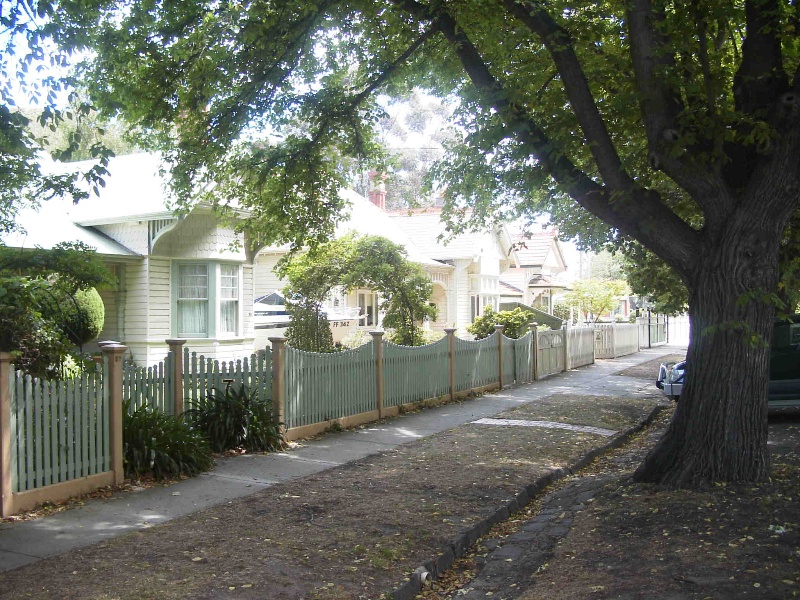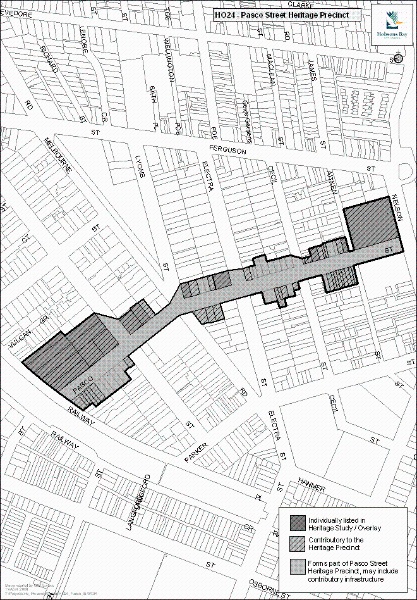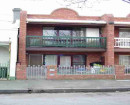Pasco Street Heritage Precinct
Aitken Street (part), Pasco Street (part) , Williamstown WILLIAMSTOWN, HOBSONS BAY CITY
-
Add to tour
You must log in to do that.
-
Share
-
Shortlist place
You must log in to do that.
- Download report



Statement of Significance
What is Significant?
The Pasco Street Heritage Precinct, which comprises all land in HO24 and generally includes properties with a frontage or side boundary to Pasco Street, Williamstown.
How is it Significant?
The Pasco Street Heritage Precinct is of local historic and aesthetic significance to the City of Hobsons Bay.
Why is it Significant?Historically, Pasco Street includes examples of some of the earliest residential and commercial development in Williamstown and is important for its ability to illustrate important phases in the development of the city from during the nineteenth and early twentieth century, which includes the historical associations of the educational institutional and ecclesiastical buildings with the establishment and fostering of the Williamstown community and the associations of the owners and occupiers of some early residential buildings (late 1850s onwards) with Williamstown's early and important role as Melbourne's port. (AHC criteria A4 and D2)
Aesthetically, Pasco Street is an integral part of the Government Survey precinct and exhibits characteristics that are typical of those streets within this broader precinct as well as elements that are unique. The typical characteristics include:
- Early or rare building styles and types such as the basalt houses and the unifying effect throughout the precinct of groups of predominantly Victorian and Edwardian era houses with common or similar characteristics of design, siting and scale that create cohesive and homogeneous streetscapes. Many are externally intact and others, although altered, still retain their distinctive form and siting and hence contribute to the precinct.
- The sections of the roadway in its basic early layout and the exotic street planting that combines with exotic planting in private gardens to reinforce and enhance the period expression of the precinct.
The distinctive elements of Pasco Street are:
- The presence of a number of substantial nineteenth century houses and public buildings such as 'Tudor House' that were designed by noted Melbourne architects.
- The group of Queen Anne villas near the intersection with Melbourne Road.
(AHC criterion E1)
On this basis, the following properties and other elements contribute to the significance of the precinct:
-Pasco Street (odd) 15-19, 21, 25-31, 47, 57-61, 69 and 83-93.
-Pasco Street (even) 4-16, 22-32, 50-56, 62-64 and 70-76.
- Early street layout
Please note that some heritage places within this precinct may also have an individual citation in this Study.
27&29 Pasco Street are not the original dwellings - reconstruction has occurred in accordance with the ICOMOS Burra Charter.
-
-
Pasco Street Heritage Precinct - Physical Description 1
This precinct generally includes properties with a frontage to Pasco Street between Railway Place and Nelson Place.
On the allotment at the north-western corner of Nelson Place and Pasco Street is the Holy Trinity complex, which comprises the fine bluestone Gothic Revival styled Holy Trinity Church of England and vicarage which face Nelson Place, and the Carpenter Gothic timber Sunday School Hall facing Pasco Street. Opposite the church is the visually intrusive high-rise block of flats built by the Housing Commission of Victoria in the late 1960s on the site of a large bluestone warehouse known as Bryant's Bonded Stores.
Like other streets within the Government Survey, Pasco Street is characterized by similarly styled predominantly Victorian-era hipped roof weatherboard houses, although there are notable exceptions. The two-storey, castellated Tudor House (1884) and the former Wesleyan Church (1854-66) are strong corner elements at the intersection of Electra and Pasco Streets. There is a fine group of three Queen Anne villas near the intersection of Melbourne Road, which contrast with the early basalt house, 'Ashton Villa', on the opposite corner. Across Melbourne Road, 'St Ayles' is a fine example of an asymmetrical Italianate villa with an original front fence.
Commercial and public buildings such as the former Crown Hotel and the former Manchester Unity Oddfellows Hall near the corner of Cecil Street are visually prominent elements in this section of Pasco Street. Other non-residential buildings include the Williamstown High School complex at the south-west corner of Verdon Street and, in particular the dynamic Moderne two storey classroom block facing Pasco Street. The original school building is just visible to the rear of this building.
Pasco Street retains its nineteenth century street layout with a central sealed road and unmade gravel verges, and the original bluestone guttering has been retained except in the block east of Cecil Street. Elm trees are planted in an avenue formation in the gravel verges along its length; the best and most mature examples are found in the block between Electra Street and Melbourne Road. Few front fences are original, but most are low and many are in a related reproduction period style such as timber pickets.
Pasco Street Heritage Precinct - Integrity
Integrity
Moderate to Low. Inappropriate and unrelated postwar development disrupts the complete expression of Pasco Street as an historic precinct, however, there remain cohesive groups of nineteenth century and early twentieth century housing.
Pasco Street Heritage Precinct - Usage/Former Usage
Context
An integral part of the broader Government Survey precinct.
Pasco Street Heritage Precinct - Historical Australian Themes
Principal Australian Historical Theme(s)
Making Suburbs
Pasco Street Heritage Precinct - Physical Description 2
Associations
Various - Refer to individual citations.
Heritage Study and Grading
Hobsons Bay - Hobsons Bay Heritage Study
Author: Hobsons Bay City Council
Year: 2006
Grading:
-
-
-
-
-
FORMER MORGUE
 Victorian Heritage Register H1512
Victorian Heritage Register H1512 -
WILLIAMSTOWN PRIMARY SCHOOL
 Victorian Heritage Register H1639
Victorian Heritage Register H1639 -
RESIDENCE
 Victorian Heritage Register H0487
Victorian Heritage Register H0487
-
..esterville
 Yarra City
Yarra City -
1 Alfred Crescent
 Yarra City
Yarra City -
1 Barkly Street
 Yarra City
Yarra City
-
-












